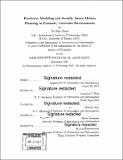Predictive modeling and socially aware motion planning in dynamic, uncertain environments
Author(s)
Chen, Yu Fan, Ph. D. Massachusetts Institute of Technology
DownloadFull printable version (19.14Mb)
Other Contributors
Massachusetts Institute of Technology. Department of Aeronautics and Astronautics.
Advisor
Jonathan P. How.
Terms of use
Metadata
Show full item recordAbstract
Advances in sensor technologies and computing power have spurred a surge of interest in autonomous vehicles, such as indoor service robots and self-driving cars. The potential applications of such vehicles are predicted to have far-reaching impacts on human mobility and the economy at large. While there has been significant progress in the past decade, reliable, fully autonomous navigation remains challenging, particularly in environments that entail frequent interactions with other dynamic agents. Specifically, safe and time efficient navigation may require (i) predictive modeling of agents with unknown intents (e.g., goals), and (ii) cooperative collision-free motion planning. These issues are not only hard research problems individually, but also tightly coupled since the nearby agents' motion could be affected by the vehicle's choice of action. This work focuses on the interplay between prediction and planning, and presents novel algorithmic approaches while considering various challenges arising from perceptual and computational limitations. First, a motion modeling framework is developed, which learns from data a set of commonly exhibited local motion patterns and the associated transition probabilities. This framework is designed to work with real data from onboard sensors, such as noisy position measurements and fragmented trajectory tracks due to sensor occlusion. Second, a multi-query path planning algorithm is presented, which computes a domain-specific similarity metric by learning the map's geometry. The algorithm not only enables quick local re-planning in response to frequent changes in the environment, but also allows for finding homotopically distinct paths at the route level. Third, a method for decentralized multiagent collision avoidance is developed, which uses reinforcement learning to generate a computationally efficient policy that encodes cooperative behaviors. Moreover, this approach is extended to capture subtle human navigation norms, such as passing on the right and overtaking on the left. The proposed methods are tested on hardware, and are shown to enable fully autonomous navigation at the average human walking pace through a pedestrian-rich environment.
Description
Thesis: Ph. D., Massachusetts Institute of Technology, Department of Aeronautics and Astronautics, 2017. Cataloged from PDF version of thesis. Includes bibliographical references (pages 141-151).
Date issued
2017Department
Massachusetts Institute of Technology. Department of Aeronautics and AstronauticsPublisher
Massachusetts Institute of Technology
Keywords
Aeronautics and Astronautics.